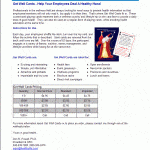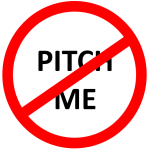Speeding up a train wreck
Health and wellness businesses trying to speed up lead generation can find themselves employing increasingly aggressive marketing tactics designed to get cautious buyers to move NOW on something–anything! And by the time we see them, many of our clients have tried “shockvertising” (Warning: the Wikipedia reference contains a disturbing example thereof).
Consider, for example:
- The pain center who wants to show people with horrible sports injuries so they can say how their PTs help clients return their lives to normal
- The diabetes center trying desperately to warn people just how bad the consequences of poor control can be…by showing pictures of people with open foot sores or amputations
- The clinical weight loss center who wants to show how Sheila lost over 135 pounds–showing, of course, a morbidly obese Sheila in the “before” pictures
Even after learning that shock ads are disallowed by advertising platforms like Google and Facebook, they ask us for workarounds. They can’t believe they’re not allowed to show before and after pictures!
After all, shock ads are memorable. People pay attention. And they can often produce fast action.
But typically, it’s the WRONG action for the business.
Smashing Pumpkins
In the 1970s, the Kansas Highway Patrol ran a Public Safety Announcement (PSA) promoting the use of seatbelts. The ad used images of pumpkins launching from the hood of a car and smashing into asphalt to depict the effects of auto accidents on unbelted occupants.
The ad disturbed viewers so much that they felt fear, disgust, and paralysis about taking any action.
Instead, they just sat there, presumably, thinking about how that pumpkin could have been their head.
A 2015 study by Renata Machova, Erika Huszarik, and Zsuzsanna Toth further confirmed that depending on generation, viewers of shock ads were either disgusted, distracted, or tuned out after watching. In similar studies, viewers seldom even remembered what the ads were for, and what remained was often a lingering disquiet that stood in the way of action.
“Change comes from within.”
There’s an old joke about a Buddhist who buys something from a food truck and pays with a twenty dollar bill. When he asks, “where’s my change?” the vendor says, “Change comes from within.”
In health and wellness marketing, not matter how important it is, change comes from within–you can’t force it.
Prochaska and Diclemente’s Transtheoretical Model, better known as “Stages of Change” model, explains how people looking to make life changes actually approach making those changes. They act on their own schedule, due to their own circumstances, and on their own timetable. They’re motivated by their own hopes and fears.
Not threats or lectures.
Most health and wellness business owners are not just financially but emotionally invested in their business. They want more than anything for others to feel the same way they do. Yet somehow they don’t connect the dots from “need to change” to “want to change.”
So in an effort to push their prospects into becoming customers, many owners of health and wellness businesses default to unloading all the benefits of taking up the kind of fitness or healthy living that changed their own lives. When they encounter significant pushback, disbelief, and emotional distancing, they assume their prospects simply don’t care about their health and need to be shown the dismal place that the road they’re currently traveling eventually leads.
And sometimes, that hard-sell, street-preacher approach gets a reaction.
Not all engagement is good.
Let’s assume for the moment that shockvertising actually works.
In fact, let’s assume that despite knowing about the resounding lack of success from the smashing pumpkins ad, you feel you’re different. You remain convinced that the best way to make your point is to show as graphically as possible just how bad things can get and to shove it as hard as you can at your audience.
Accordingly, you attempt to run a personal Facebook post with grisly images of amputated toes and diabetic wounds that just won’t heal. Your thinking is that since it’s a personal post, maybe you can get it past the Facebook Ad Gods.
Finally, let’s suppose that magically, your post doesn’t get reported for overly graphic content.
That oughta show ’em, right?
Perhaps you’re not surprised that your post gets engagement. After all, you “knew” it would.
But let’s look at the typical types of engagement it gets:
- “Oh my god. That happened to my aunt. They had to cut her foot off at the ankle. And she could have avoided it.”
- “That is so sad. It’s a shame whoever this was didn’t just forgo the daily donuts and soda.”
- “This is ridiculous. The OP (original poster) clearly has an agenda posting this kind of doom and gloom crap. I bet they’re shilling for some low-rent supplements outfit.”
- “The person in the story really needs to start on a keto diet. If they would just avoid processed foods and all that sugar they would lose weight and regain their health. I had this same problem until I tried the (insert trendy diet plan name here) plan. I didn’t even have to exercise.”
The first one is shock and terror–and NO action. The second one blames the victim. The third one blames the advertiser for sensationalism (at least that’s close to the truth), and the last one says more about the respondent’s desire to be seen as an authority than it does about your products or services–and in fact, actually pitches an alternative to your products or services!
Shock and terror, voyeurism, and flame wars are not the kind of engagement you really want. None of these are buying signs.
And that’s from a personal post, where Facebook and other social platforms allow a great deal more freedom of speech.
Now let’s look at ads.
The reasons ads get banned
A personal post with graphic content may land you in “Facebook jail” for a few days or weeks.
If you try to run that same message as an ad, you won’t get “time out.” The ad won’t run at all, it’ll take you much longer to get back into the advertising platform’s good graces. you’ll be putting your status as an advertiser at risk. You’ll also be fighting an algorithm that have already dispassionately marked you as a “bad actor.” Don’t believe us? Read Facebook’s Official Policy on Sensational Content. It prohibits:
- Depictions of violence
- Depictions of gruesome or graphic medical conditions or procedures (for instance, amputations)
- Depictions of body substance discharges or extraction (e.g., oozing wounds)
- Depictions of blood splatters, real or animated
- Depictions of graphic vehicle collisions, especially where a person is hit by a vehicle
- Depictions of the infliction of pain
Moreover, Facebook’s Advertising Policy on Personal Health further prohibits:
- Images focusing on conditions–for instance, zoomed-in pictures of acne
- Ads for weight-loss services with potential negative self-perception (fat-shaming)
- Before-and-after images with idealized results (results must be typical, and as a practical matter, almost all before-and-after types of ads seem to be summarily banned these days)
- Discriminatory content
- Inflammatory content–specifically any content that attacks, demonizes, or engages in fearmongering based on race, ethnicity, national origin, religious affiliation, caste, sex, gender identity, sexual orientation, or serious disability or disease.
- Language that directly addresses the recipient (“you should” language)
Facebook’s Advertising Policy on Personal Attributes also prohibits ads that imply a detailed knowledge of the recipient’s personal identity (including health status), for instance, “Over 60? This supplement may help prevent rectal cancer.”
But wait, there’s more! (see what I did there?) Facebook also prohibits:
- Disruptive content, including sensational language or withholding content: for example, an ad that says “you’ll NEVER BELIEVE how much weight Jenna lost after trying this ONE WEIRD TRICK!!!”
- Unacceptable business practices (pyramid schemes and many MLMs)
- Ads for unsafe substances (including some supplements)
Facebook will not tolerate any advertising that points the finger at your prospect, finds them unworthy, and tries to scare, bully, bamboozle, befuddle or shout them into buying.
Make your ads about YOU, and let your prospects decide for themselves whether to become customers.
Google Ads, too
Google has its own rules that advertisers ignore at their own peril. You are prohibited from advertising:
- Counterfeit goods
- Dangerous products or services
- Certain prescription meds, most notably painkillers, unless you are a registered pharmacy
- Clinical services such as addiction counseling that have not been pre-vetted by LegitScript, a process that can take months
- Content that is considered offensive, intolerant, or promotes hatred, violence, or discrimination
- Ads that attempt to circumvent Google Ads policies (for instance, by following the letter, not the spirit of the policy)
- Ads that violate Google’s Data Collection and Use Policies (similar to FB’s rules about abusing personal data)
- Misrepresentative ads
- Ads for sex, alcohol, gambling, or illegal drugs
The list gets updated fairly often. You can read more about Google’s specific rules for Healthcare Advertising.
Exhausting, isn’t it? Especially when all you want to do is get people to eat their broccoli and do some ab crunches! All. The. Rules! Ugh!
In case you think your maybe-it-will-run Google Ad will slip by unnoticed, consider this: one of our own Google Ads for healthcare marketing was rejected because just one of our sitelinks led to a page listing customer stories, and exactly one of those stories referenced the fact that our client was a state-licensed, LegitScript-approved clinical counseling center.
The reason Google provided was: “promoting addiction-related products and services.” And get this: wasn’t even a running ad–it was one we had disabled because we thought it might get caught if it ran. The algorithm scans even “dead” ads…for indirect links to pages containing trigger words.
Google doesn’t play around. It’s their baseball, their bat, and their game, and if you don’t play by the rules, you don’t get to play at all.
A powerful and dangerous weapon
Shock ads almost always contain text or images designed to emotionally manipulate prospects into taking action, often capitalizing on a deeply-seated, very personal fear:
- Physical unattractiveness
- Sexual impotence
- Suffering or disease
- Dying early or horribly
- Physical handicaps, limitations, or impairment
- Inability to live independently
- Otherness
Many are also biased or misleading and benefit only the advertiser. In some cases, they cause financial, physical, or emotional harm.
If those are your ads, they’re not ads, they’re propaganda. That’s why Facebook and Google disallow them. But if you’re still not convinced, ask yourself what running shock ads tells prospects about the kind of business you actually are.
But isn’t advertising all about emotion?
A friend of mine used to say:
“People eliminate choices using logic. But they make choices using emotion.”
It’s tempting to conclude that emotion plays no role in “white hat” advertising. But it’s actually okay to use emotion in ads. In fact, the right product for the right person makes both you and your customer happy.
It’s just not okay to try to force people to fall in love with you by lying, manipulating, or gaslighting them.
So how can any right-thinking health, fitness, or wellness business reach clients emotionally?
To appeal sympathetically and authentically to well-qualified prospects, provide honest answers to the 7 Showstopper Questions every prospect needs answered.
It’s as simple as that.
No long-winded lectures or act-now-or-regret-it sales closing techniques are ever going to turn Jane Prospect into a customer; and chasing after her with increasingly desperate pleas or threats isn’t going to change that.
Netting it all out
Radial STRONGLY RECOMMENDS an ethical approach to identifying and targeting people actively looking for products and services like yours with a message reinforcing why your offerings are the high-value choice for customers like them.
Starting with questions about who you consider your best customer(s), we’ll want to get to know him or her: her hopes, dreams, and concerns. What’s on his mind today? Why are they looking at you, and why now?
When you listen closely, you’ll hear what draws people to your business. Listen even more closely and they will tell you in their own words.
Your advertising must speak to that person and address that need. That person already wants you and sees your business’s potential value, so it’s not manipulating them to offer proof.
By focusing on a positive message that highlights how your health, fitness, or wellness business has shown the way for others, you can help prospects find their own.
If you shout, lecture, threaten, or manipulate, you will turn people away just like that angry street preacher; not because people don’t care about salvation, but because they don’t care for the way it’s being sold.
We want to help you do things right.
If you let us, we’ll help you discover the folks who really, really want what you have and believe it’s worth the price. We’ll help you find where they gather and speak to their hopes, dreams, and sense of self-efficacy. And they’ll respond with curiosity, interest, and often, a purchase.
That’s what good, honest, clean, ethical marketing is all about, and that’s what helps build happy customer stories where you’re the hero.
For more information about what ethical marketing looks like and why you shouldn’t fear it, check out our article: Is Marketing Your Health or Wellness Business a Necessary Evil?




